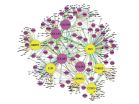Why does red meat increase the risk for cardiovascular disease? Blame our gut bacteria
2014-11-04
(Press-News.org) New research provides details on how gut bacteria turn a nutrient found in red meat into metabolites that increase the risk of developing heart disease. Publishing in the November 4th issue of the Cell Press journal Cell Metabolism, the findings may lead to new strategies for safeguarding individuals' cardiovascular health.
Previous research led by Dr. Stanley Hazen, of Lerner Research Institute and the Miller Family Heart and Vascular Institute at Cleveland Clinic, revealed a pathway by which red meat can promote atherosclerosis, or hardening of the arteries. Essentially, bacteria in the gut convert L-carnitine, a nutrient abundant in red meat, into a compound called trimethylamine, which in turn changes to a metabolite named trimethylamine-N-oxide (TMAO), which promotes atherosclerosis. Now Dr. Hazen and his team extend their earlier research and identify another metabolite, called gamma-butyrobetaine, that is generated to an even greater extent by gut bacteria after L-carnitine is ingested, and it too contributes to atherosclerosis.
The researchers found that gamma-butyrobetaine is produced as an intermediary metabolite by microbes at a rate that is 1,000-fold higher than the formation of trimethylamine in the gut, making it the most abundant metabolite generated from dietary L-carnitine by microbes in the mouse models examined. Moreover, gamma-butyrobetaine can itself be converted into trimethylamine and TMAO. Interestingly, however, the bacteria that produce gamma-butyrobetaine from L-carnitine are different from the bacterial species that produce trimethylamine from L-carnitine.
The discovery that metabolism of L-carnitine involves two different gut microbial pathways, as well as different types of bacteria, suggests new targets for preventing atherosclerosis—for example, by inhibiting various bacterial enzymes or shifting gut bacterial composition with probiotics and other treatments.
"The findings identify the pathways and participants involved more clearly, and help identify targets for therapies for interventions to block or prevent heart disease development," says Dr. Hazen. "While this is into the future, the present studies may help us to develop an intervention that allows one to 'have their steak and eat it too' with less concern for developing heart disease."
INFORMATION:
Dr. Hazen also notes that consumers should be cautious of taking supplements that contain gamma-butyrobetaine. Over-the-counter nutritional supplements are not regulated by the Food and Drug Administration and need to demonstrate only minimal safety data.
ELSE PRESS RELEASES FROM THIS DATE:
2014-11-04
ATLANTA—A new statistical test that looks at the patterns of high-frequency network activity flow from brain signals can help doctors pinpoint the exact location of seizures occurring in the brain and make surgery more effective, according to researchers at Georgia State University and Emory University School of Medicine. The findings are published in the journal Epilepsia.
Emory researchers Dr. Charles Epstein, Dr. Robert Gross and Dr. Jon Willie; Dr. Bhim Adhikari, a post doctoral researcher at Georgia State, and Dr. Mukesh Dhamala, an associate professor of ...
2014-11-04
ROCHESTER, Minn. — In an international study, Mayo Clinic researchers and collaborators have identified genetic markers that may help in identifying individuals who could benefit from the alcoholism treatment drug acamprosate. The findings, published in the journal Translational Psychiatry, show that patients carrying these genetic variants have longer periods of abstinence during the first three months of acamprosate treatment.
Acamprosate is a commonly prescribed drug used to aid patients in recovery from alcoholism. Mayo researchers studied the association between ...
2014-11-04
Urban legend states that New York City has as many rats as people: roughly 8 million; but a new analysis suggests there are nowhere near as many.
The analysis classified rat sightings by city lot, of which there are roughly 842,000 in New York City. The researchers estimated 40,500 rat-inhabited lots in the city. By liberally assuming that 40 to 50 rats belong to a typical colony and that one full colony occupies each rat-inhabited lot, the researchers concluded that 2 million would be an extremely generous estimate of the city's rat population.
"While the rat population ...
2014-11-04
PROVIDENCE, R.I. [Brown University] — Type 2 diabetes (T2D) and cardiovascular disease (CVD) appear to have a lot in common. They share risk factors such as obesity and they often occur together. If they also share the same genetic underpinings, then doctors could devise a way to treat them together too. With that hope in mind, scientists applied multiple layers of analysis to the genomics of more than 15,000 women. In a new study they report finding eight molecular pathways shared in both diseases as well as several "key driver" genes that appear to orchestrate the ...
2014-11-04
A global research effort has resolved a major biosecurity issue by determining that four of the world's most destructive agricultural pests are one and the same.
The Oriental fruit fly, the Philippine fruit fly, the Invasive fruit fly, the Carambola fruit fly, and the Asian Papaya fruit fly cause incalculable damage to horticultural industries and food security across Asia, Africa, the Pacific, and parts of South America. More than 40 researchers from 20 countries examined available evidence and determined that the Carambola fruit fly is a distinct species, but the other ...
2014-11-04
A new study found that 43% of nursing students indulge in hazardous alcohol consumption, with 14.9% of men and 18.7% of women meeting criteria for hazardous drinkers.
Hazardous drinkers were more likely to be young, to smoke, and to live outside the family nucleus.
"Alcohol-prevention activities should envisage greater protection of university settings, particularly where future health professionals are involved," wrote the authors of the Journal of Advanced Nursing study.
INFORMATION:
...
2014-11-04
New research indicates that scent associated with polar bear paws conveys information that may affect the animals' social and reproductive behavior. This chemical form of communication was likely shaped by the environmental constraints of Arctic sea ice.
Scientists worry that this communication may be impacted if scent trails are disrupted due to increased fracturing of sea ice from climate change.
"Effective communication is essential for successful reproduction in solitary, wide-ranging animals," said Dr. Megan Owen, lead author of the Journal of Zoology study. "Developing ...
2014-11-04
A geologist in Syracuse University's College of Arts and Sciences has demonstrated that earthquakes--not climate change, as previously thought--affect the rate of landslides in Peru.
The finding is the subject of an article in Nature Geoscience (Nature Publishing Group, 2014) by Devin McPhillips, a research associate in the Department of Earth Sciences. He co-wrote the article with Paul Bierman, professor of geology at The University of Vermont; and Dylan Rood, a lecturer at Imperial College London (U.K.).
"Geologic records of landslide activity offer rare glimpses ...
2014-11-04
The current Ebola outbreak in West Africa has grown exponentially since May, indicating inadequate global response. A new analysis indicates that the outbreak's fatality rate is over 70%—rather than 50% as previously claimed by the World Health Organization—and that the total number of affected individuals could exceed 1 million by early next year.
As long as the number of infected people rises exponentially, the likelihood of exporting Ebola to other countries does as well.
"The disease itself hasn't changed, with essentially the same fatality rate and ...
2014-11-04
A new study of 63 women with varied infant feeding experiences reveals that breastfeeding mothers may feel shame if they breastfeed in public due to exposure, while those who do not breastfeed may experience shame through 'failing' to give their infant the 'best start.'
Breastfeeding and non-breastfeeding mothers may also experience shame through inadequate support, judgment, and condemnation, leading to feelings of failure, inadequacy, and isolation.
"This study highlights the difficulties and tensions that breastfeeding and non-breastfeeding women can face in hospital ...
LAST 30 PRESS RELEASES:
[Press-News.org] Why does red meat increase the risk for cardiovascular disease? Blame our gut bacteria

